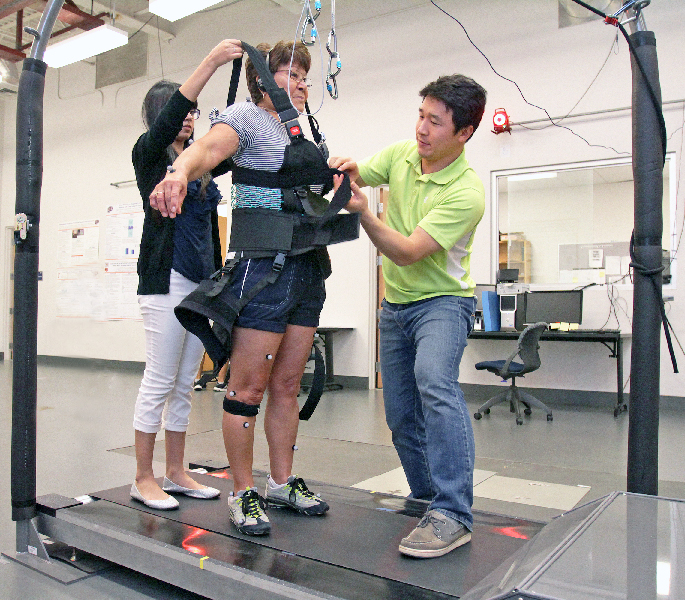Originally posted April 9, 2015

EL PASO, Texas – Researchers at The University of Texas at El Paso are using vibration technology to reduce the risk of falls among Hispanic older adults and people with multiple sclerosis.
Since June 2014, about 50 Hispanic adults 65 years and older have participated in a research study by Feng Yang, Ph.D., an assistant professor in the Department of Kinesiology in UTEP’s College of Health Sciences. After receiving an eight-week whole-body vibration training program, the risk of falls among those seniors involved in the study was significantly reduced.
“Whole-body vibration is a relatively novel training approach that we can use to reduce the risk of falls for older adults or for people with movement disorders,” Yang explained. The study’s co-principal investigators are Loretta Dillon, DPT, clinical associate professor in the Department of Physical Therapy, and Xiaogang Su, Ph.D., associate professor in the Department of Mathematical Sciences. “This vibration can increase muscle strength and improve the body balance, and it can also improve the function in mobility, sensation, bone density and all those factors that are closely related to falls.”
With support from a $78,148 grant from The Retirement Research Foundation, Yang developed an eight-week training program for 100 adults ages 65 years and older to investigate if whole-body vibration training can reduce their risk of falling and if the training is still effective three months after they finish the program.
Yang said the results of the study so far have been encouraging. Besides the significant improvements in all fall risk factors among the participants, their slip-related falls on a special treadmill, which simulates a slipping sensation, and the fall incidences in everyday living have been reduced by about 70 percent and 30 percent, respectively.
In whole-body vibration therapy, a person typically stands on a vibration platform. As the machine vibrates, the transmission of mechanical vibrations and oscillations to the human body forces all muscles to contract and relax tens of times each second, and leads to physiological and neuromuscular changes that can reduce falls among individuals at greater fall risk.
Participants use the whole-body vibration machine in UTEP’s Stanley E. Fulton Biomechanics and Motor Behavior Laboratory for five minutes, three times a week for eight weeks.
Yang evaluates the participants’ progress by measuring their muscle strength, bone density, sensation, range of motion, fear of falling, and functional mobility. All participants’ real-life fall incidences also are monitored.
To test if the training has improved their resistance to falls, participants walk on a special treadmill, which simulates a slipping sensation by suddenly changing the moving direction of the belt. Participants are strapped into a harness to prevent injury.
Yang also received a separate $43,297 pilot grant from the National Multiple Sclerosis Society to use the technique to study its effect on preventing falls in individuals with MS.
Yang is currently recruiting 40 participants for his multiple sclerosis study. The National Multiple Sclerosis Foundation estimates that more than 400,000 people in the U.S. have MS. This project has particular significance for the El Paso region, which has been identified as a nationally recognized cluster of MS by the society.
Through whole-body vibration training, Yang hopes to develop a training paradigm that involves the least amount of physical activity for individuals with MS to reduce their risk of falls.
Yang is looking for participants with mild to moderate MS who have fallen at least once in the past six months for his study. Participants will take part in whole-body vibration training for five minutes a day, three days a week for eight weeks.
Yang and his collaborators also are planning to apply vibration therapy to individuals with other movement dysfunctions, such as stroke and Parkinson’s disease.
To participate in either study, contact Yang at 915-747-8228 or 915-747-6010 or by email at fyang@utep.edu.